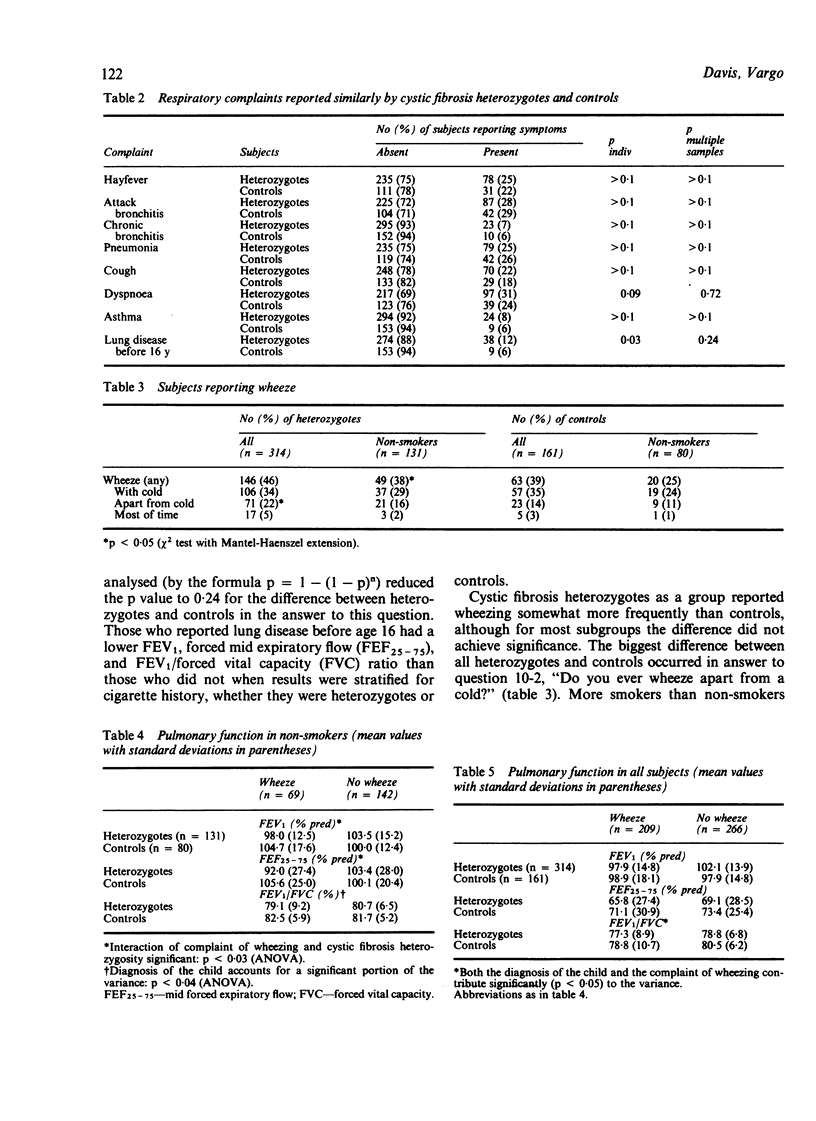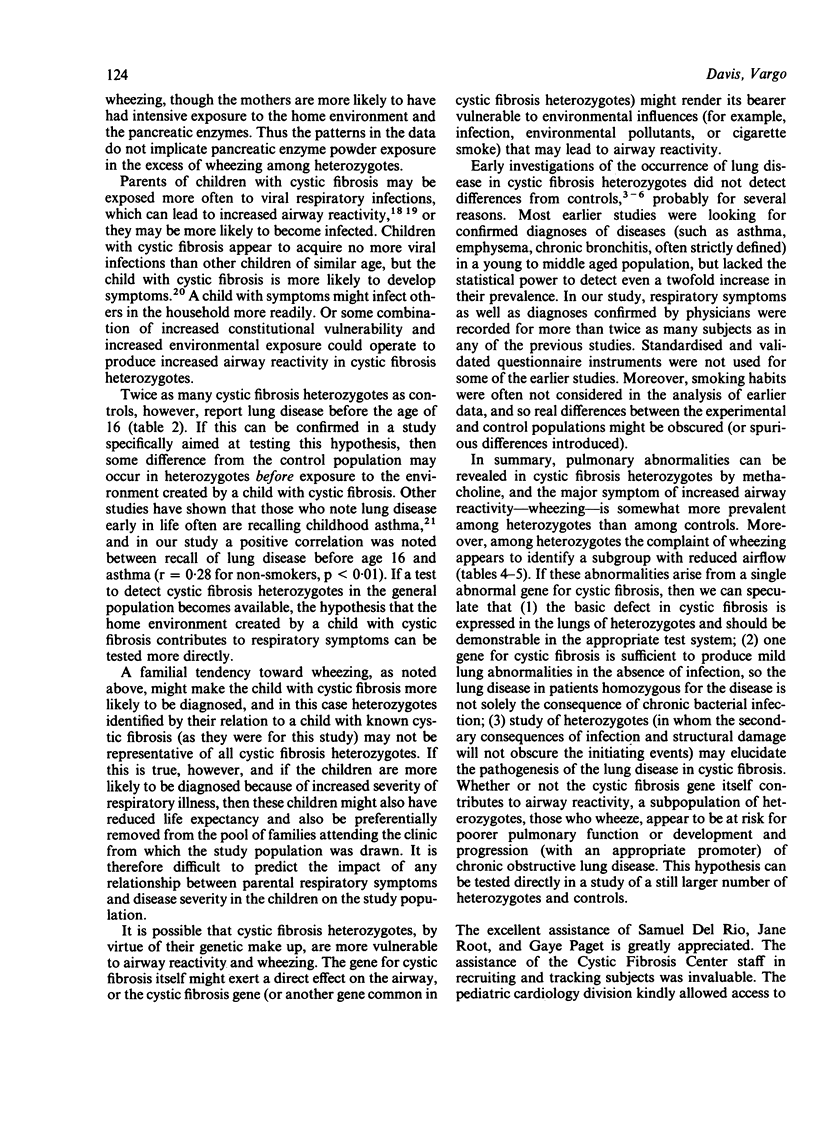Abstract
Parents of children with cystic fibrosis have been reported to have a high prevalence of increased airway reactivity, but these studies were done in a select young, healthy, symptomless population. In the present study respiratory symptoms were examined in 315 unselected parents of children with cystic fibrosis and 162 parents of children with congenital heart disease (controls). The cardinal symptom of airway reactivity, wheezing, was somewhat more prevalent in cystic fibrosis parents than in controls, but for most subgroups this increased prevalence did not reach statistical significance. Among those who had never smoked, 38% of obligate heterozygotes for cystic fibrosis but only 25% of the controls reported wheezing (p less than 0.05). The cystic fibrosis parents who had never smoked but reported wheezing had lower FEV1 and FEF25-75, expressed as a percentage of the predicted value, than control parents; and an appreciable portion of the variance in pulmonary function was contributed by the interaction of heterozygosity for cystic fibrosis with wheezing. For cystic fibrosis parents, but not controls, the complaint of wheezing significantly contributed to the prediction of pulmonary function (FEV1 and FEF25-75). In addition, parents of children with cystic fibrosis reported having lung disease before the age of 16 more than twice as frequently as control parents. Other respiratory complaints, including dyspnoea, cough, bronchitis, and hay fever, were as common in controls as in cystic fibrosis heterozygotes. These data are consistent with the hypothesis that heterozygosity for cystic fibrosis is associated with increased airway reactivity and its symptoms, and that the cystic fibrosis heterozygotes who manifest airway reactivity and its symptoms may be at risk for poor pulmonary function.
Full text
PDF





Selected References
These references are in PubMed. This may not be the complete list of references from this article.
- ANDERSON C. M., FREEMAN M., ALLAN J., HUBBARD L. Observations on (i) sweat sodium levels in relation to chronic respiratory disease in adults and (ii) the incidence of respiratory and other disease in parents and siblings of patients with fibrocystic disease of the pancreas. Med J Aust. 1962 Jun 23;49(1):965–969. doi: 10.5694/j.1326-5377.1962.tb27044.x. [DOI] [PubMed] [Google Scholar]
- BATTEN J., MUIR D., SIMON G., CARTER C. The prevalence of respiratory disease in heterozygotes for the gene for fibrocystic disease of the pancreas. Lancet. 1963 Jun 22;1(7295):1348–1350. doi: 10.1016/s0140-6736(63)91926-3. [DOI] [PubMed] [Google Scholar]
- BERNARD E., ISRAEL L., DEBRIS M. M. Chronic bronchitis and mucoviscidosis. Am Rev Respir Dis. 1962 Jan;85:22–24. doi: 10.1164/arrd.1962.85.1.22. [DOI] [PubMed] [Google Scholar]
- Barter C. E., Campbell A. H. Relationship of constitutional factors and cigarette smoking to decrease in 1-second forced expiratory volume. Am Rev Respir Dis. 1976 Mar;113(3):305–314. doi: 10.1164/arrd.1976.113.3.305. [DOI] [PubMed] [Google Scholar]
- Britt E. J., Cohen B., Menkes H., Bleecker E., Permitt S., Rosenthal R., Norman P. Airways reactivity and functional deterioration in relatives of COPD patients. Chest. 1980 Feb;77(2 Suppl):260–261. doi: 10.1378/chest.77.2.260. [DOI] [PubMed] [Google Scholar]
- Burrows B., Knudson R. J., Lebowitz M. D. The relationship of childhood respiratory illness to adult obstructive airway disease. Am Rev Respir Dis. 1977 May;115(5):751–760. doi: 10.1164/arrd.1977.115.5.751. [DOI] [PubMed] [Google Scholar]
- Davis P. B. Autonomic and airway reactivity in obligate heterozygotes for cystic fibrosis. Am Rev Respir Dis. 1984 Jun;129(6):911–914. doi: 10.1164/arrd.1984.129.6.911. [DOI] [PubMed] [Google Scholar]
- Davis P. B., Simpson D. M., Paget G. L., Turi V. Beta-adrenergic responses in drug-free subjects with asthma. J Allergy Clin Immunol. 1986 Jun;77(6):871–879. doi: 10.1016/0091-6749(86)90386-6. [DOI] [PubMed] [Google Scholar]
- Empey D. W., Laitinen L. A., Jacobs L., Gold W. M., Nadel J. A. Mechanisms of bronchial hyperreactivity in normal subjects after upper respiratory tract infection. Am Rev Respir Dis. 1976 Feb;113(2):131–139. doi: 10.1164/arrd.1976.113.2.131. [DOI] [PubMed] [Google Scholar]
- Ferris B. G. Epidemiology Standardization Project (American Thoracic Society). Am Rev Respir Dis. 1978 Dec;118(6 Pt 2):1–120. [PubMed] [Google Scholar]
- Ganier M., Lieberman P. IgE mediated hypersensitivity to pancreatic extract (PE) in parents of cystic fibrosis (CF) children. Clin Allergy. 1979 Mar;9(2):125–132. doi: 10.1111/j.1365-2222.1979.tb01531.x. [DOI] [PubMed] [Google Scholar]
- Hall W. J., Douglas R. G., Jr Pulmonary function during and after common respiratory infections. Annu Rev Med. 1980;31:233–238. doi: 10.1146/annurev.me.31.020180.001313. [DOI] [PubMed] [Google Scholar]
- Hallett W. Y., Knudson A. G., Jr, Massey F. J., Jr Absence of detrimental effect of the carrier state for the cystic fibrosis gene. Am Rev Respir Dis. 1965 Nov;92(5):714–724. doi: 10.1164/arrd.1965.92.5.714. [DOI] [PubMed] [Google Scholar]
- KARLISH A. J., TARNOKY A. L. Mucoviscidosis as a factor in chronic lung disease in adults. Lancet. 1960 Sep 3;2(7149):514–515. doi: 10.1016/s0140-6736(60)91542-7. [DOI] [PubMed] [Google Scholar]
- Knudson R. J., Slatin R. C., Lebowitz M. D., Burrows B. The maximal expiratory flow-volume curve. Normal standards, variability, and effects of age. Am Rev Respir Dis. 1976 May;113(5):587–600. doi: 10.1164/arrd.1976.113.5.587. [DOI] [PubMed] [Google Scholar]
- Menkes H. A. Airways reactivity and the need for a simple test. Am Rev Respir Dis. 1980 Apr;121(4):619–620. doi: 10.1164/arrd.1980.121.4.619. [DOI] [PubMed] [Google Scholar]
- WOOD J. A., FISHMAN A. P., REEMTSMA K., BARKER H. G., DI SANT'AGNESE P. A. A comparison of sweat chlorides and intestinal fat absorption in chronic obstructive pulmonary emphysema and fibrocystic disease of the pancreas. N Engl J Med. 1959 May 7;260(19):951–957. doi: 10.1056/NEJM195905072601901. [DOI] [PubMed] [Google Scholar]
- Weiss S. T., Speizer F. E. Increased levels of airways responsiveness as a risk factor for development of chronic obstructive lung disease. What are the issues? Chest. 1984 Jul;86(1):3–4. doi: 10.1378/chest.86.1.3. [DOI] [PubMed] [Google Scholar]


